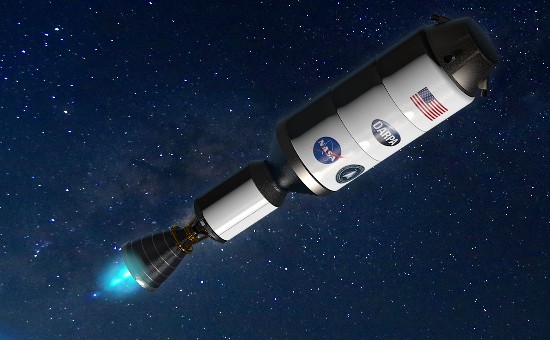Chemical-powered rockets have fuelled the modern space age, but space is a big place and the distances between our planet and almost anywhere else are huge. The best chemical rockets do is get us from here to Mars in six months.
Spacecraft with no humans aboard can manage the distance and time reasonably well. But a crewed spaceship flying for that amount of time has to deal with a lot of extra baggage: water, oxygen, rocket fuel, food, radiation shielding and other life support necessities. That means enormous payloads that can either be lifted to orbit in a single launch, or through multiple launches with assembly completed in near-Earth space.
There are no service stations in space for a crewed spaceship to pull up and get tanks topped up while grabbing other needed supplies. Ideally, an infrastructure like that between Earth, the Moon, and Mars, would make a great deal of sense. But so far, no space agency or private company has considered taking up the challenge of building this type of long-distance travel infrastructure. We have the technology to do it, but neither the money nor wherewithal.
Another solution is to use an alternate fuel source and technology to get us from Earth to Mars and beyond much faster. The advantages of such a solution cannot be understated. Back in the 1970s, a little more than a decade after Sputnik was launched, both the Soviet Union and the United States were pursuing the development of a nuclear option. The two countries explored using small nuclear fission explosions to create thrust in what was called pulse propulsion, and nuclear thermal using fission reactions to heat gasses to provide thrust.
For uncrewed missions, a different type of nuclear technology has been deployed. RTG Radioisotope Thermal Generators (RTG). RTG technology uses heat from the radioactive decay of plutonium fuel to provide energy and warmth to robotic spacecraft where solar arrays won’t work. This is the type of nuclear thermal power used on the Cassini mission to Saturn. It is also the technology deployed to keep the two NASA-Martian rovers, Curiosity and Perseverance operating in the hostile surface environment of Mars. The energy derived from RTGs is not meant to be a propulsive force.
With NASA planning to send crewed missions to Mars sometime in the 2030s, a different type of nuclear thermal power is about to be built. The U.S. Defense Advanced Research Projects Agency (DARPA), along with NASA and Lockheed Martin, are to begin making a nuclear thermal rocket. Called DRACO, which stands for Demonstration Rocket for Agile Cislunar Operations, the goal is to have a successful in-orbit demonstration of the technology.
Dr. Tabitha Dodson, who holds a doctorate in applied physics from the Air Force Institute of Technology, and a Ph.D. in mechanical and aerospace engineering from George Washington University, is DRACO’s program manager. In a DARPA press release, she states that DRACO will “give the nation leap-ahead propulsion capability.” She describes the development as one that will achieve “high thrust similar to in-space chemical propulsion but…two-to-three-times more efficient.” DRACO’s success will lead to a future in space that will be powered by nuclear rockets.
DRACO is a revival of NASA’s experimental efforts to build a nuclear-thermal-powered rocket in the 1970s. Think of a nuclear power plant that heats water turning it into steam to power a turbine but instead of water substitute hydrogen or another chemical, and instead of a turbine, a rocket nozzle.
In the 1970s the Soviets experimented with nuclear-thermal-rocket technology that used ammonia and alcohol as propellants. The U.S. developed NERVA, a prototype that used liquid hydrogen. Then both countries dropped nuclear-thermal power in space as an option.
The DRACO demonstration will revive NERVA and will use High-Assay Low-Enriched Uranium (HALEU) to generate controlled fission. Cryogenic hydrogen on board will heat up to provide thrust. Future nuclear-thermal propulsion may not carry hydrogen but rather will harvest the gas using giant cowcatchers to catch hydrogen atoms floating in space.
Nuclear-thermal rockets have another advantage over the chemical rockets we use today. There is no need to carry a liquid oxygen payload along with the ignitable fuel. Additional advantages include engines that will be far less complex.
And the final advantage is rockets that can turn a six-month endurance test, when travelling between Earth and Mars, into a trip that takes as little as 30 Earth days.
The current timetable is to launch DRACO in 2027.










[…] is no secret that NASA is working with the U.S. Defense Research Projects Agency (DARPA) on nuclear thermal-powered (NTP) rockets […]